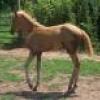What is known about Ea?
Forums
Quote:Sorry if I'm being
[quote]Sorry if I'm being annoying, but I'm unfamiliar with Ea and ea. Can someone explain, please?[/quote]
I hope no one on this forum is ever considered annoying for just asking a question.
(a) stands for an additional recessive allele on extension. If I'm remembering correctly there was at least one incidence of a stallion who had tested EE siring a chestnut foal. Turns out he carried this rare allele that expressed exactly like e. It tested as E because it was not covered by the test for e.
I think it is in this paper,
I think it is in this paper, but I can't be positive and I don't have my hands on the paper at the moment to double check (it is buried somewhere in my moving boxes in the garage).
Rieder S, Taourit S, Mariat D, Langlois B, Guérin G. Mutations in the agouti (ASIP), the extension (MC1R), and the brown (TYRP1) loci and their association to coat color phenotypes in horses (Equus caballus). Mammalian Genome. 2001;12(6):450-455.
Cantabrian Coast horses most
Cantabrian Coast horses most commonly have it. All fairly rare breeds. Pottoka, Jaca Navarra, Euskal Herriko Mendiko Zaldia, Burguete. I know there was some debate somewhere over High Brow Cougar the QH possibly having it since he has been described as testing heterozygous 'e' while being as chestnut as a chestnut can be. But that could likely have been a mix up with the word homozygous.
JNFerrigno wrote:I found this
[quote=JNFerrigno]I found this http://horsehints.org/StudyChestnutGene…
http://www.biomedcentral.com/1756-0500/…]
Thank you that was actually pretty helpful...they only thing they forgot to mention is that most labs only tested for E and e so that ea showed up as E (black) on the results.
I would love to see High Brow Cougar tested for ea because he comes from a long line of chestnuts/sorrels, from some very prominant and well known bloodlines. I know that 95 percent of my horses share blood with him...not sure about Luna or Destiny (most rescues don't come with pedigrees... ymwhisle )




There is an older paper that
There is an older paper that discusses Ea, but mutation is so rare that it is not seen enough to include it in the standard extension test. E is wild type (aka what the DNA should look like) while e is a mutation, hence why the test looks just for the e. I believe that you can request a test for ea, which was located shortly after the chestnut 'E' horses cropped up.